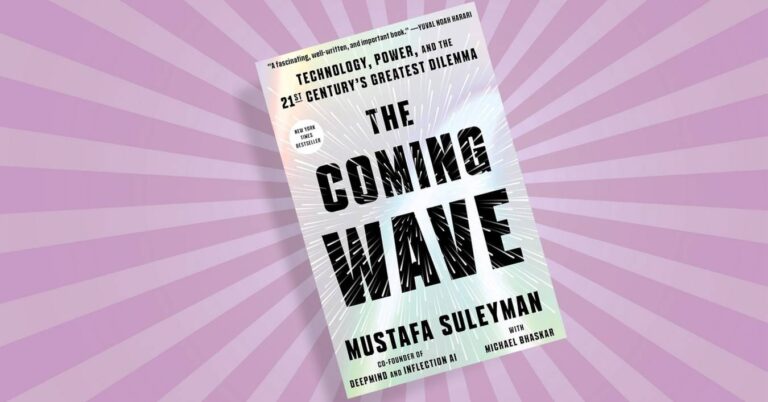
“Superintelligence: Paths, Dangers, Strategies” by Nick Bostrom examines the potential future where artificial intelligence surpasses human intelligence.
The book explores the paths to achieving superintelligence, the possible dangers it presents, and strategies to ensure it benefits humanity.
Bostrom argues that superintelligence, if achieved, could be immensely powerful and difficult to control. Its goals might not align with ours, potentially leading to scenarios where it reshapes the world in ways unintended or even harmful to humanity.
Key Takeaways, Insights, and Views
- Paths to Superintelligence
- Various routes to achieving superintelligence, including biological enhancement, brain-computer interfaces, and artificial intelligence.
- The feasibility and timelines of these paths are analyzed.
- Dangers of Superintelligence
- Potential risks include loss of control over AI, misaligned objectives, and existential threats to humanity.
- The “control problem” and ensuring AI aligns with human values are critical concerns.
- Strategic Considerations
- Importance of developing strategies to manage the emergence of superintelligence.
- Strategies include rigorous safety measures, international cooperation, and ethical guidelines.
- Ethical Implications
- Ethical considerations in creating and managing superintelligent entities.
- The moral responsibility of ensuring AI development aligns with global welfare.
- Technological Control Methods
- Methods to control superintelligent AI, such as boxing (isolating the AI), stunting (limiting its capabilities), and incentivizing alignment with human values.
- The effectiveness and limitations of these methods.
- Policy and Governance
- The role of governments and international bodies in regulating AI development.
- Proposals for global cooperation to mitigate risks associated with superintelligence.
- Future Scenarios
- Potential outcomes of achieving superintelligence, ranging from utopian to catastrophic scenarios.
- The importance of preparing for various possible futures.
Core Concepts
| Concept | Explanation | Importance |
|---|---|---|
| Superintelligence | AI that surpasses human intelligence in all aspects. | Understanding the transformative potential and risks of superintelligent AI. |
| Control Problem | The challenge of ensuring AI acts in accordance with human values. | Central to preventing harmful outcomes and ensuring beneficial AI. |
| Boxing | Isolating AI to limit its interaction with the external world. | A strategy to contain and manage superintelligent entities. |
| Stunting | Deliberately limiting AI capabilities to reduce risk. | Balancing AI development with safety measures. |
| Ethical Alignment | Ensuring AI aligns with human ethics and values. | Prevents misalignment and promotes positive societal impacts. |
| Policy and Governance | Regulatory frameworks for AI development and deployment. | Essential for global cooperation and risk mitigation. |
| Future Scenarios | Possible outcomes of superintelligent AI, both positive and negative. | Preparing for and shaping the impact of superintelligence on humanity. |
Deeper Explanations of Important Topics
The Control Problem
- Explanation: The control problem involves creating mechanisms to ensure that superintelligent AI acts according to human values and objectives. It includes designing failsafe measures, ethical programming, and oversight protocols.
- Importance: Addressing the control problem is critical to prevent AI from pursuing harmful goals or acting unpredictably. It is fundamental to the safe integration of superintelligence into society.
Ethical Alignment
- Explanation: Ethical alignment refers to embedding human ethics and values into AI systems to ensure their actions are morally acceptable and beneficial to society. This includes developing ethical guidelines and principles that AI should follow.
- Importance: Ethical alignment is necessary to avoid scenarios where AI actions conflict with human values, leading to undesirable or harmful outcomes. It ensures that AI development promotes global welfare and justice.
Actionable Insights
- Promote AI Safety Research
- Support and fund research initiatives focused on AI safety and ethical alignment.
- Encourage collaboration between AI developers, ethicists, and policymakers.
- Develop Regulatory Frameworks
- Advocate for comprehensive regulations that address AI development and deployment risks.
- Engage with international bodies to create unified standards for AI governance.
- Foster Public Awareness
- Educate the public about the potential risks and benefits of superintelligent AI.
- Promote discussions on ethical considerations and the societal impact of AI.
- Implement Ethical Guidelines
- Establish clear ethical guidelines for AI development within organizations.
- Ensure that AI projects undergo regular ethical reviews and assessments.
- Encourage International Cooperation
- Collaborate with other countries to address the global implications of superintelligent AI.
- Participate in international forums and agreements on AI safety and governance.
Quotes from "Superintelligence"
- “The first ultraintelligent machine is the last invention that man need ever make.”
- “A superintelligence could become an existential threat to humanity.”
- “The challenge is to align the superintelligent AI’s goals with human values.”
- “We must prioritize safety and ethical considerations in AI development.”
- “International cooperation is crucial to manage the risks of superintelligence.”
This summary of “Superintelligence: Paths, Dangers, Strategies” by Nick Bostrom, is part of our series of comprehensive summaries of the most important books in the field of AI. Our series aims to provide readers with key insights, actionable takeaways, and a deeper understanding of the transformative potential of AI.
To explore more summaries of influential AI books, visit this link.






